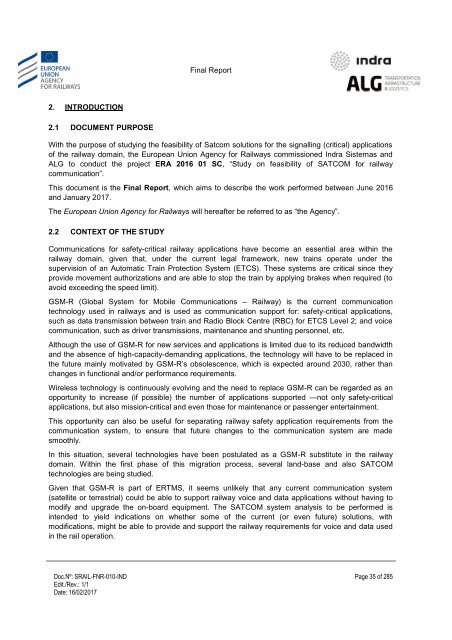Study on feasibility of SATCOM for railway communication
SRAIL-FNR-010-IND%20-%20FinalReport_v1.1_20170216
SRAIL-FNR-010-IND%20-%20FinalReport_v1.1_20170216
Create successful ePaper yourself
Turn your PDF publications into a flip-book with our unique Google optimized e-Paper software.
Final Report<br />
2. INTRODUCTION<br />
2.1 DOCUMENT PURPOSE<br />
With the purpose <strong>of</strong> studying the <strong>feasibility</strong> <strong>of</strong> Satcom soluti<strong>on</strong>s <strong>for</strong> the signalling (critical) applicati<strong>on</strong>s<br />
<strong>of</strong> the <strong>railway</strong> domain, the European Uni<strong>on</strong> Agency <strong>for</strong> Railways commissi<strong>on</strong>ed Indra Sistemas and<br />
ALG to c<strong>on</strong>duct the project ERA 2016 01 SC, ―<str<strong>on</strong>g>Study</str<strong>on</strong>g> <strong>on</strong> <strong>feasibility</strong> <strong>of</strong> <strong>SATCOM</strong> <strong>for</strong> <strong>railway</strong><br />
communicati<strong>on</strong>‖.<br />
This document is the Final Report, which aims to describe the work per<strong>for</strong>med between June 2016<br />
and January 2017.<br />
The European Uni<strong>on</strong> Agency <strong>for</strong> Railways will hereafter be referred to as ―the Agency‖.<br />
2.2 CONTEXT OF THE STUDY<br />
Communicati<strong>on</strong>s <strong>for</strong> safety-critical <strong>railway</strong> applicati<strong>on</strong>s have become an essential area within the<br />
<strong>railway</strong> domain, given that, under the current legal framework, new trains operate under the<br />
supervisi<strong>on</strong> <strong>of</strong> an Automatic Train Protecti<strong>on</strong> System (ETCS). These systems are critical since they<br />
provide movement authorizati<strong>on</strong>s and are able to stop the train by applying brakes when required (to<br />
avoid exceeding the speed limit).<br />
GSM-R (Global System <strong>for</strong> Mobile Communicati<strong>on</strong>s – Railway) is the current communicati<strong>on</strong><br />
technology used in <strong>railway</strong>s and is used as communicati<strong>on</strong> support <strong>for</strong>: safety-critical applicati<strong>on</strong>s,<br />
such as data transmissi<strong>on</strong> between train and Radio Block Centre (RBC) <strong>for</strong> ETCS Level 2; and voice<br />
communicati<strong>on</strong>, such as driver transmissi<strong>on</strong>s, maintenance and shunting pers<strong>on</strong>nel, etc.<br />
Although the use <strong>of</strong> GSM-R <strong>for</strong> new services and applicati<strong>on</strong>s is limited due to its reduced bandwidth<br />
and the absence <strong>of</strong> high-capacity-demanding applicati<strong>on</strong>s, the technology will have to be replaced in<br />
the future mainly motivated by GSM-R‘s obsolescence, which is expected around 2030, rather than<br />
changes in functi<strong>on</strong>al and/or per<strong>for</strong>mance requirements.<br />
Wireless technology is c<strong>on</strong>tinuously evolving and the need to replace GSM-R can be regarded as an<br />
opportunity to increase (if possible) the number <strong>of</strong> applicati<strong>on</strong>s supported —not <strong>on</strong>ly safety-critical<br />
applicati<strong>on</strong>s, but also missi<strong>on</strong>-critical and even those <strong>for</strong> maintenance or passenger entertainment.<br />
This opportunity can also be useful <strong>for</strong> separating <strong>railway</strong> safety applicati<strong>on</strong> requirements from the<br />
communicati<strong>on</strong> system, to ensure that future changes to the communicati<strong>on</strong> system are made<br />
smoothly.<br />
In this situati<strong>on</strong>, several technologies have been postulated as a GSM-R substitute in the <strong>railway</strong><br />
domain. Within the first phase <strong>of</strong> this migrati<strong>on</strong> process, several land-base and also <strong>SATCOM</strong><br />
technologies are being studied.<br />
Given that GSM-R is part <strong>of</strong> ERTMS, it seems unlikely that any current communicati<strong>on</strong> system<br />
(satellite or terrestrial) could be able to support <strong>railway</strong> voice and data applicati<strong>on</strong>s without having to<br />
modify and upgrade the <strong>on</strong>-board equipment. The <strong>SATCOM</strong> system analysis to be per<strong>for</strong>med is<br />
intended to yield indicati<strong>on</strong>s <strong>on</strong> whether some <strong>of</strong> the current (or even future) soluti<strong>on</strong>s, with<br />
modificati<strong>on</strong>s, might be able to provide and support the <strong>railway</strong> requirements <strong>for</strong> voice and data used<br />
in the rail operati<strong>on</strong>.<br />
Doc.Nº: SRAIL-FNR-010-IND<br />
Edit./Rev.: 1/1<br />
Date: 16/02/2017<br />
Page 35 <strong>of</strong> 285


